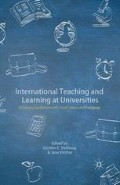Abstract
As Vinther, Chang, and Coverdale-Jones indicate in this volume, international teaching and learning at universities is not something that merely began in the late twentieth century but one that, in some respects, originated at least two centuries ago. Granted, the twenty-first century is the primary focus at this moment, when at least ten million university students participate in some form of international education in the East and the West, either because they go abroad to study or because programs and branch campuses come to them from abroad. In addition, many, many millions more are affected by the presence of these international students and activities on campuses.
Access this chapter
Tax calculation will be finalised at checkout
Purchases are for personal use only
Preview
Unable to display preview. Download preview PDF.
References
Australian Bureau of Statistics. (2011). “Australian Social Trends, Dec 2011.” Accessed August 14, 2014. http://www.abs.gov.au/ausstats/abs@.nsf/Lookup/4102.0Main+Features20Dec+2011
Choudaha, R., L. Chang, and Y. Kono. (2013). “International Student Mobility Trends 2013: Towards Responsive Recruitment Strategies.” WES Research and Advisory Services. Accessed August 14, 2014. http://wenr.wes.org/2013/03/wenr-march-2013-international-student-mobility-trends-2013-towards-responsive-recruitment-strategies/
Coverdale-Jones, T. (2012a). “Introduction: The Widening Context of Transnational Higher Education.” In T. Coverdale-Jones (Ed.), Transnational Higher Education in the Asian Context. Houndmills: Palgrave Macmillan. 1–12.
—. (2012b). “Internationalisation of Higher Education in Japan and the UK—Similarities and Contrasts.” In T. Coverdale-Jones (Ed.), Transnational Higher Education in the Asian Context. Houndmills: Palgrave Macmillan. 49–67.
Department of Foreign Affairs and International Trade: Canada. (2012). “Economic Impact of International Education in Canada—An Update.” Accessed June 5, 2014. http://www.international.gc.ca/education/assets/pdfs/economic_impact_en.pdf
Foucault, M. (1970). The Order of Things: An Archaeology of the Human Sciences. Ed. R. D. Laing, Ed. New York: Vintage Books.
HEA (Higher Education Academy). (2014). “Internationalisation.” Accessed August 15, 2014. https://www.heacademy.ac.uk/workstreams-research/themes/internationalisation
Hull, W. F. (1978). Foreign Students in the United States. New York: Praeger.
Jones, E. (2013). “Internationalization and Employability: The Role of Intercultural Experiences in the Development of Transferable Skills.” Public Money and Management. 33.2: 95–104.
Lingenfelter, J., and S. G. Lingenfelter. (2003). Teaching Cross-Culturally: An Incarnational Model for Learning and Teaching. Grand Rapids: Baker Academic.
Lyotard, J. F. (1984). The Postmodern Condition: A Report on Knowledge. G. Bennington, Trans. Minneapolis: University of Minnesota Press.
Marshall, B. K. (1992). Teaching the Postmodern: Fiction and Theory. New York: Routledge.
NAFSA: Association of International Educators. (2011). “The Economic Benefits of International Education to the United States for the 2010–2011 Academic Year: A Statistical Analysis.” Downloaded June 20, 2014. http://www.nafsa.Org/_/file/_/eis2011/usa.pdf
Reid, T. R. (1999). Confucius Lives Next Door: What Living in the East Teaches Us about Living in the West. New York: Vintage Books.
Ryan, J. (2010). “Chinese Learners: Misconceptions and Realities.” In J. Ryan and G. Slethaug (Eds.), International Education and the Chinese Learner. Hong Kong: Hong Kong University Press. 37–56.
Ryan, J. (Ed.). (2013). Cross-Cultural Teaching and Learning for Home and International Students: Internationalization of Pedagogy and Curriculum in Higher Education. London: Routledge.
Shi, L. (2006). “The Successors to Confucianism or a New Generation? A Questionnaire Study on Chinese Students’ Culture of Learning English.” Language, Culture and Curriculum. 19.1: 122–147.
Slethaug, G. E. (2007). Teaching Abroad: International Education and the Cross-Cultural Classroom. Hong Kong: Hong Kong University Press.
Slethaug, G., and J. Manjula. (2012a). “The Business of Education: Improving International Student Learning Experiences in Malaysia.” World Journal of Social Sciences. 2.6: 179–199.
—. (2012b). “Interpreting Malaysian Results in International Education Assessments.” In T. Coverdale-Jones (Ed.), Transnational Higher Education in the Asian Context. Houndmills: Palgrave Macmillan. 195–215.
Tan, T., and J. Weidman. (2012). “Chinese Graduate Students Adjustments to Academic Demands in American Universities.” In T. Coverdale-Jones (Ed.), Transnational Higher Education in the Asian Context. Houndmills: Palgrave Macmillan. 118–131.
Watt, H. (2012). “Analysis: Money Is Driving Force of Rise in Foreign Students Seeking UK Degree.” The Telegraph, June 9. Downloaded June 10, 2014. http://www.telegraph.co.uk/education/universityeducation/9358095/Analysis-money-is-driving-force-of-rise-in-foreign-students-seeking-UK-degree.html
Editor information
Copyright information
© 2015 Gordon E. Slethaug and Jane Vinther
About this chapter
Cite this chapter
Slethaug, G.E. (2015). Conclusion: International Teaching and Learning at Universities—Achieving Equilibrium with Local Culture and Pedagogy. In: Slethaug, G.E., Vinther, J. (eds) International Teaching and Learning at Universities. Palgrave Macmillan, New York. https://doi.org/10.1057/9781137475145_9
Download citation
DOI: https://doi.org/10.1057/9781137475145_9
Publisher Name: Palgrave Macmillan, New York
Print ISBN: 978-1-349-69287-3
Online ISBN: 978-1-137-47514-5
eBook Packages: Palgrave Education CollectionEducation (R0)

